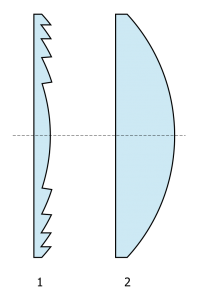The new consumer version of the Oculus Rift has just been released and there’s been a lot of buzz about the new hybrid fresnel lenses and how they compare with those in the HTC Vive Pre. Incidentally, based on the reviews, these may be different from the lenses that I demoed at CES and apparently, the screen door effect is very minimal. Here’s a close-up of the new Rift lens and for comparison, the HTC Vive Pre lens, thanks to Mashable and Enterprise_NX-01 on Reddit.
HMD optics serve a purpose very similar to that of reading glasses, but with a much higher diopter value, since the display is much closer than normal reading distance. These are fast lenses, which would presumably have small radii of curvature. That limits the lens diameter and field of view (FOV), a problem for HMD lens designers such as myself, who aim to achieve monocular FOVs greater than 100 deg with reasonable eye relief.
A fresnel lens has optical power without curvature, so the lens and FOV can be quite large, as evidenced by the StarVR. It’s basically a conventional lens that has been segmented into rings and compressed to make it as thin as possible. As you can see in the Wikipedia graphic below, the local curvature is preserved, while the thickness is reduced significantly. There’s no reason why one can’t add a fresnel surface to a thick, curved lens to increase power further (without adding more curvature) and that’s exactly what HTC and Oculus are doing. Fresnel surfaces also contribute little or no Petzval field curvature, which helps, since we don’t yet have good options for curved displays to integrate into HMDs.

You may notice from the images linked above that the new Rift lens has a much higher groove density than the HTC Vive Pre lens. A high groove density provides a better approximation of the parent lens. In theory, this should result in higher quality images. However, the more segments there are, the more peaks there are to scatter from and at some point, you may start to see diffractive effects. This scatter and diffraction can result in halos around bright sources and other artifacts.
If designed properly, a low groove density lens can provide higher contrast, because there are fewer peaks to scatter from. However, this coarser approximation of the parent lens will generally produce images that are less sharp.
The flat sides of the grooves are “dead space”. The degree to which they are illuminated depends on their orientation relative to the incident light, as well as the groove depth and density. The idea is to design these facets so they’re minimally illuminated and oriented perpendicular to the eye, but since the display produces light from a wide field of view and the eye can rotate, that’s a difficult task. Reflections and scatter from these surfaces are likely the primary source of “streaks”, “flares”, and “halos” reported by users of both the Rift CV1 and Vive Pre when viewing off-axis. Artifacts can also arise from internal ghost images, since anti-reflection coatings on the grooves are of limited effectiveness if used at all.
As I mentioned in my January post, the next step for HMDs could be phase fresnel or other diffractive optic lenses, which solve the same issues as fresnel lenses do, as well as providing achromatization and sharper, higher contrast viewing. However, no lens form is perfect. The diffraction efficiency is maximized at the design wavelength and falls off on either end of the spectrum. What doesn’t get diffracted into the desired order becomes stray light. Some light is lost to diffractive orders adjacent to the design order and produces halos. There’s also scatter from microscopic surface roughness. These battles have been fought by others and we can learn from what they’ve done. I plan to dig into Canon’s laminated DO lens technology in an upcoming post.
Leave a Reply
You must be logged in to post a comment.